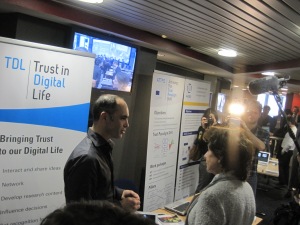Trust in the Digital World Conference 2015
March 2, 2015 Leave a comment
Ronny Bjones, Alliances director Trust in Digital Life association.
I wanted to share my observations of the TDW event in Madrid on 25-26 of February 2015.
At TDW you see three communities coming together. We heard policy makers on the different trust-related programs they are working on such as eIDAS, data protection, NIS, big data, etc.
From the other side you see academia and industry explaining their progress in their projects which are frequently connected to these policy programs.
This gives a fantastic synergy and a lot of networking.
The demonstrations
Overall I loved the demonstrations people are bringing forward. I saw some great new 2FA approaches from KUL/COSIC & qKey.
The Trustseed digital signature demonstration in which I was involved, was also a high-light. It showed new advances how specialized cloud based trust services can make it easy for relying parties to incorporate complex signature scenarios. Trustseed was the winner of last year’s TDL sprint award.
Great points Policy Makers brought forward
The EC policy makers informed us very well on their trust related programs. We had Jacub Boratynski on the cybersecurity programs backed by Afonso Ferreira on the strategic research agenda in cyberspace. Afonso had a clear call to be involved in the NIS platforms.
Marta Nagy-Rothengass showed the business opportunity on big data and how the EC is enabling these opportunities. I was impressed by one slide which showed how their investment into the “one digital economy” can bring the greatest benefits for the European economy. Way bigger than any of the other programs.
She made an interesting point on what she called the ‘Snowden effect”. The “Snowden effect” might slow down business to benefit from big data because of all the regulations around it. Companies are afraid to step into this field. I thought this was interesting because I always believed there would be a great opportunity for European companies in this space.
Great points Industry Speakers brought forward
From the industry I saw a great session from Paul Wang NEC on Smart Cities. He had this picture of sixteen cameras all inline monitoring one street. These cameras belonged to different organizations and did different operations. Some of them might recognize individuals and map these individuals to the most wanted list, a service operated by the police. Others will see pictures with mosaics to anonymize individuals. These were operated by other services which could not invade the privacy of individuals. He pointed out a very valid point that we need non-repudiation to protect the authenticity of these pictures. He showed an example of a clearly manipulated picture. Imagine the impact to individuals when this happens.
Dr. Richard Benjamin from Telefonica gave some great examples of big data. Showing how we can get new insights by overlapping earthquake strengths in a certain area with SMS and telephone usage. This could show where people are in trouble and it would be possible to send ambulances to these areas. Another example was to map people, correlated to demographic statistics to shopping areas to learn who is actually shopping there.
He scared me a bit with a quit innocent example. He showed statistics of running football players (speed, location on the field, etc.). He told that Telefonica bought the data and did some analysis on it which showed that Messy was actually not such a big runner. Anyway this reminds me about some behaviors I spot with relatives. We all have relatives who store old stuff such as old VCR’s because who knows, maybe in the future, it might be worth a few bucks. Probably not though but this is exactly the same behavior which is triggering big data. These services are storing this data because maybe somebody will spend some bucks on it. A lot of data is very useful but many services will collect data because maybe in the future it can be monetized. But are they taking the right measures to protect that data and is it really worth it to store the data in the first place?
The whole big data industry is fragile. It can be in risk from big incidents, in the same way how the nuclear industry was wiped in the USA by the “three mile island” incident.
There is no way that these viewpoint are exhaustive. I probably missed some great sessions but I hope by sharing these, more people will have some food for thought.
Read more blogs from Ronny Bjones on the subject of Identity at: http://blog.beejones.net/
